Alexandra Palace, a magnificent architectural masterpiece, stands as a testament to Victorian grandeur and modern entertainment. Once a royal retreat, it has evolved into a vibrant cultural hub, offering a captivating blend of history, architecture, and entertainment.
Alexandra Palace has played a pivotal role in British history, hosting iconic events and leaving an indelible mark on popular culture. Its stunning architecture, lush parkland, and diverse attractions make it a must-visit destination for anyone seeking a unique and unforgettable experience.
History of Alexandra Palace
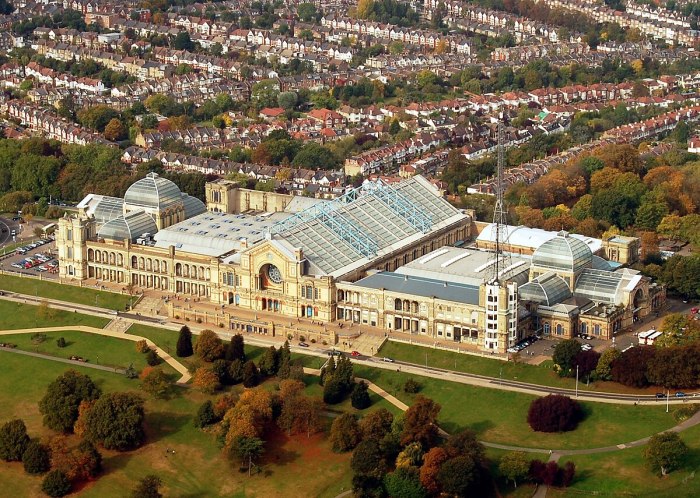
Alexandra Palace, located in North London, has a rich history that spans over a century. It was originally conceived as a “People’s Palace” to provide entertainment and education for the working class of London.
The palace was designed by Sir Charles Barry, the architect of the Houses of Parliament, and built between 1863 and 1873. It was officially opened by Queen Victoria in 1875 and quickly became a popular destination for Londoners. The palace housed a variety of attractions, including a concert hall, a theatre, a museum, and a library. It also had extensive gardens and grounds, which were used for recreation and sports.
Over the years, Alexandra Palace has undergone several renovations and expansions. In 1883, a fire destroyed much of the palace, but it was quickly rebuilt. In the early 20th century, the palace was used as a military hospital during World War I and as a broadcasting center during World War II.
After the war, Alexandra Palace was once again renovated and reopened to the public. It has since become a major cultural and entertainment venue, hosting a variety of events, including concerts, exhibitions, and sporting events. The palace is also home to the Alexandra Palace Theatre, which is one of the oldest surviving theatres in London.
Key Events in the History of Alexandra Palace
- 1863: Construction of Alexandra Palace begins.
- 1873: Alexandra Palace is completed and opens to the public.
- 1883: A fire destroys much of Alexandra Palace.
- 1886: Alexandra Palace is rebuilt.
- 1914-1918: Alexandra Palace is used as a military hospital during World War I.
- 1939-1945: Alexandra Palace is used as a broadcasting center during World War II.
- 1946: Alexandra Palace is reopened to the public.
- 1967: The Alexandra Palace Theatre opens.
- 1980s: Alexandra Palace is renovated and expanded.
- 2010s: Alexandra Palace undergoes further renovations and expansions.
Evolution of Alexandra Palace
Alexandra Palace has evolved over the years from its original purpose as a “People’s Palace” to a major cultural and entertainment venue. It has also been used for a variety of other purposes, including as a military hospital and a broadcasting center.
The palace has been renovated and expanded several times over the years to meet the changing needs of its users. It is now a modern and versatile venue that is used for a wide range of events.
Architecture and Design of Alexandra Palace
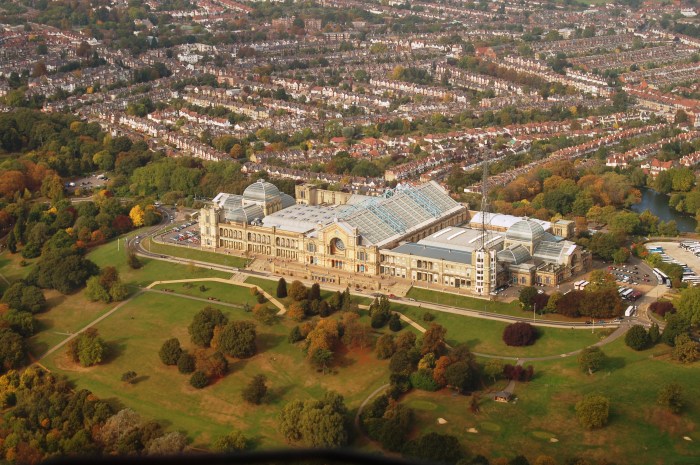
Alexandra Palace is a magnificent Victorian structure that showcases a blend of architectural styles. Its design reflects the grandeur and opulence of the Victorian era, while incorporating elements from various architectural movements.
Exterior Design
The exterior of Alexandra Palace is characterized by its imposing facade, featuring a central tower flanked by two wings. The palace’s exterior walls are constructed from red brick and Bath stone, giving it a distinctive and elegant appearance. The facade is adorned with intricate carvings, decorative moldings, and large arched windows that flood the interior with natural light.
The central tower, known as the Grand Tower, is the focal point of the palace’s exterior. It rises to a height of 168 feet and features a clock tower and a viewing platform that offers panoramic views of London and the surrounding countryside.
Interior Design
The interior of Alexandra Palace is equally impressive, with a grand central hall, a series of reception rooms, and a large ballroom. The grand hall is decorated with a stunning coffered ceiling and a marble floor, creating a sense of grandeur and opulence.
Alexandra Palace, with its stunning views of London, offers a unique experience. For a breathtaking perspective, head to the 230 fifth rooftop bar. Overlooking the palace and the city skyline, this chic bar offers an unforgettable ambiance. Afterward, return to Alexandra Palace for its lush parklands, boating lake, and historic architecture, making it a perfect destination for relaxation and exploration.
The reception rooms are adorned with intricate plasterwork, elaborate chandeliers, and large windows that overlook the palace’s grounds. The ballroom, known as the Great Hall, is the largest room in the palace and features a sprung dance floor and a stage for performances.
Alexandra Palace, a majestic landmark in North London, offers stunning views and a rich history. If you’re seeking a coastal escape, 30a florida beckons with its pristine beaches and charming towns. Upon your return, Alexandra Palace invites you to immerse yourself in its iconic architecture, vibrant events, and breathtaking vistas, making it a captivating destination that seamlessly blends heritage and modernity.
Architects Involved
Alexandra Palace was designed by a team of architects, including John Johnson, James Pennethorne, and John Young. Johnson was responsible for the overall design of the palace, while Pennethorne designed the central tower and Young designed the interior.
Alexandra Palace, with its panoramic views of London, is a beautiful spot to explore. For those seeking a coastal getaway, alicante offers stunning beaches, vibrant nightlife, and a rich cultural heritage. After your Spanish adventure, return to Alexandra Palace for its lush parklands and thrilling ice rink, making it an ideal destination for all ages.
Cultural Significance of Alexandra Palace
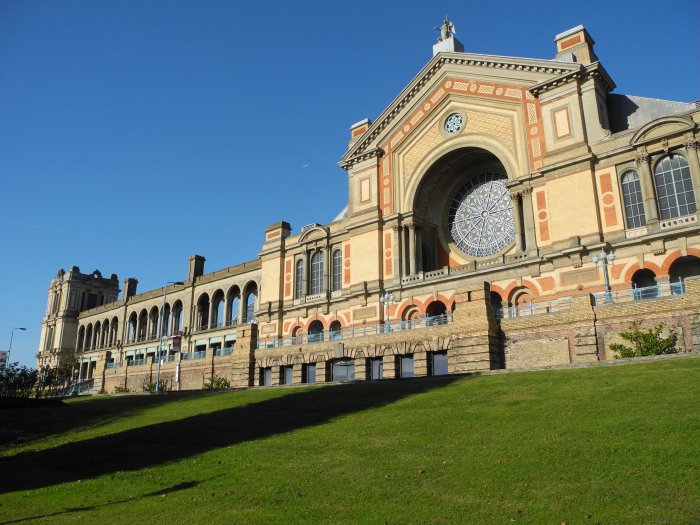
Alexandra Palace holds immense cultural significance as a renowned venue for a wide range of events and exhibitions. Its grand architecture and picturesque setting have made it a popular destination for both locals and tourists alike.
Throughout history, the palace has played a pivotal role in shaping the cultural landscape of London. It has hosted countless exhibitions, concerts, and sporting events, attracting millions of visitors over the years. The Great Exhibition of 1873, showcasing the latest advancements in science and technology, was a particularly notable event that cemented the palace’s status as a cultural hub.
Role in Popular Culture
Alexandra Palace has also made its mark in popular culture, appearing in numerous films and television shows. Its iconic facade and sprawling grounds have provided a backdrop for productions such as “The Crown,” “Sherlock,” and “Doctor Who.” The palace’s association with popular culture has further enhanced its allure and made it a recognizable landmark for people worldwide.
Notable Events
Over the years, Alexandra Palace has hosted a diverse array of events that have left a lasting impact on British society. Some of the most notable include:
- The first public demonstration of television by John Logie Baird in 1928
- The launch of the BBC Television Service in 1936
- The first televised FA Cup Final in 1938
- The first live broadcast of the Eurovision Song Contest in 1957
- The Live Aid concert in 1985, which raised funds for famine relief in Ethiopia
These events have not only showcased the palace’s versatility as a venue but have also contributed to its cultural significance as a place where history has been made.
Alexandra Palace Park and Grounds
Alexandra Palace Park is a 196-acre (80 ha) park that surrounds Alexandra Palace. The park is open to the public and offers a variety of amenities and activities, including gardens, sports facilities, and walking trails. The park is also home to a variety of wildlife, including deer, foxes, and squirrels.
The park is divided into several distinct areas, including the formal gardens, the rose garden, the Japanese garden, and the woodland walk. The formal gardens are located in front of the palace and feature a variety of flower beds, sculptures, and fountains. The rose garden is home to over 1,000 roses of different varieties. The Japanese garden is a tranquil space that features a pond, a waterfall, and a teahouse. The woodland walk is a 2-mile (3.2 km) trail that winds through the park’s woodland.
The park also offers a variety of sports facilities, including a cricket pitch, a football pitch, and a tennis court. There is also a children’s playground and a café.
Natural Features
The park is home to a variety of wildlife, including deer, foxes, and squirrels. The park is also home to a variety of trees, including oak, beech, and pine. The park’s ponds are home to a variety of fish, including carp and tench.
Alexandra Palace Today
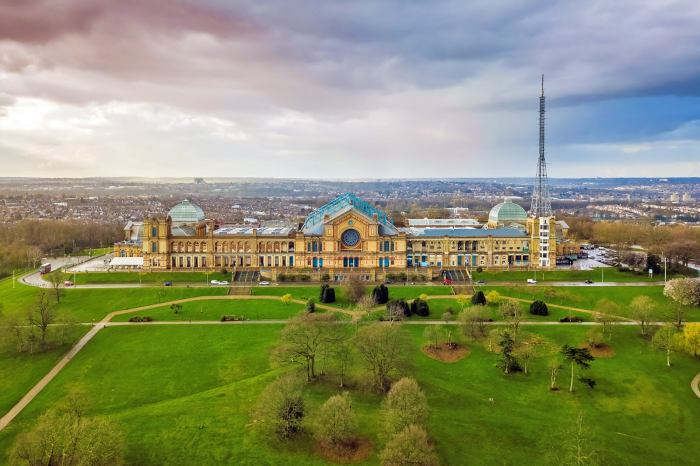
Alexandra Palace is a multi-faceted venue that caters to a diverse audience. It serves as a popular tourist destination, offering a captivating blend of history, culture, and entertainment. The palace also plays a pivotal role as a hub for events and exhibitions, hosting an array of captivating experiences throughout the year.
Ongoing restoration and preservation efforts are meticulously undertaken to maintain the grandeur and architectural integrity of Alexandra Palace. These endeavors ensure that future generations can continue to appreciate the palace’s timeless beauty and historical significance.
Tourist Destination
Alexandra Palace welcomes countless visitors eager to explore its rich tapestry of attractions. The palace boasts stunning panoramic views of London, accessible through the iconic Alexandra Palace Park and Grounds. Visitors can immerse themselves in the palace’s captivating history by embarking on guided tours that unveil its fascinating past.
- Alexandra Palace hosts an array of captivating exhibitions, showcasing diverse themes ranging from art and design to science and technology.
- The palace offers a plethora of dining options, from casual cafes to fine dining experiences, catering to the culinary preferences of every visitor.
- The Alexandra Palace Theatre presents a diverse program of live performances, including music, dance, and theatrical productions.
Events and Exhibitions, Alexandra palace
Alexandra Palace is renowned for hosting an array of prestigious events and exhibitions. The palace’s versatile spaces can accommodate gatherings of various sizes and formats, making it an ideal venue for corporate functions, conferences, and weddings.
- The Great British Beer Festival, an annual celebration of craft beer, attracts thousands of enthusiasts to Alexandra Palace.
- The London Coffee Festival showcases the latest trends and innovations in the world of coffee, drawing coffee aficionados from around the globe.
- Alexandra Palace hosts a variety of music festivals throughout the year, featuring a diverse range of genres and renowned artists.
Restoration and Preservation
Alexandra Palace is a Grade II listed building, recognizing its architectural and historical significance. Ongoing restoration and preservation efforts are essential to ensure the palace’s longevity and continued enjoyment by future generations.
- The Alexandra Palace Restoration and Conservation Trust, a dedicated charity, plays a crucial role in overseeing the palace’s preservation.
- Regular maintenance and repairs are carried out to preserve the palace’s structural integrity and aesthetic appeal.
- Sensitive restoration projects are undertaken to restore original features and enhance the palace’s overall condition.
Wrap-Up
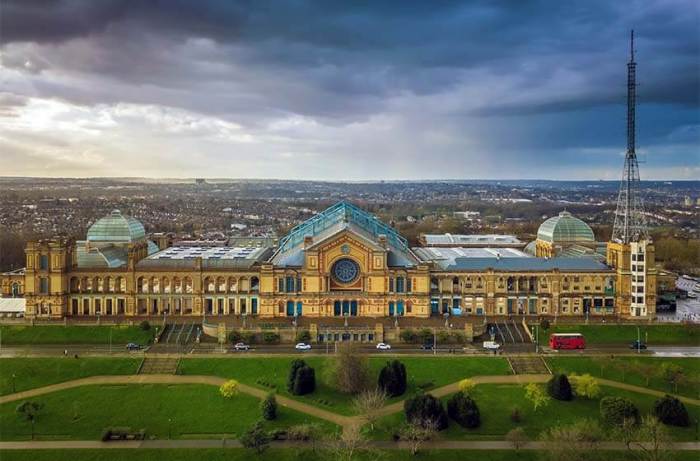
Alexandra Palace continues to enchant visitors with its rich history, architectural splendor, and ever-evolving offerings. Whether you seek historical exploration, cultural immersion, or simply a day of leisure, Alexandra Palace promises an unforgettable experience that will leave a lasting impression.
Clarifying Questions
What is the history of Alexandra Palace?
Alexandra Palace was built in 1873 as a public entertainment venue. It was originally known as the Alexandra Palace and Park and was intended to be a place where people could enjoy the outdoors and attend cultural events.
What are the architectural highlights of Alexandra Palace?
Alexandra Palace is a Grade II listed building and is considered to be one of the finest examples of Victorian architecture in London. The palace is made of red brick and terracotta and features a grand central tower, two wings, and a large terrace.
What events are held at Alexandra Palace?
Alexandra Palace hosts a wide variety of events throughout the year, including concerts, exhibitions, conferences, and sporting events. The palace is also a popular wedding venue.